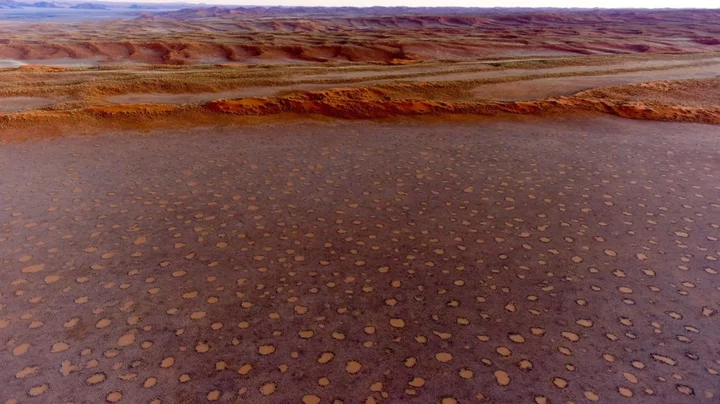
New study suggests blue light from phones may drastically alter puberty
Blue light emitted from the screens of phones, tablets and televisions could induce puberty early, a study has found. In the modern day, children are raised with devices all around them, with many having a phone or tablet to keep them entertained from a young age. But, researchers in Turkey have discovered that it exposure to the blue light such devices give off could speed up the onset of puberty. Teams from the Gazi University and Bilkent City Hospital in Ankara revealed how they saw the effect in male rats, which could suggest a link between device screens and early childhood development. Their findings were presented at the 61st Annual European Society for Paediatric Endocrinology Meeting in The Hague and published in the Frontiers in Endocrinology journal. The study emulates the same findings that were observed in female rats, where early puberty was seen. Lead researcher Dr. Aylin Kılınç Uğurlu, of Bikent City Hospital, said: “For the first time, we found a direct relationship between blue light exposure and early puberty in male rats.” They continued: “Our findings align with our previous work on female rats, which also showed similar effects, thereby providing a more comprehensive view of how blue light may influence puberty in both male and female rats.” As part of the study, 18 male rats, all 21 days old, were split into three groups. Two of the groups were assigned either six or 12 hours of blue light exposure per day. The last group was a control and was not exposed to any blue light from screens. Results showed that the rats with exposure to blue light experienced signs of puberty “significantly earlier” compared with the control group. Uğurlu noted in a news report: “I want to emphasise that this is a rat study and direct results cannot be interpreted for humans. “However, we provide an experimental foundation to further investigate the health consequences of ever-increasing screen time in modern society.” Researchers hope to continue their study on the effects of blue light on rats to “understand its long-term effects on reproductive organ damage and fertility”. Uğurlu continued: “Ultimately, this research could lead to preventative measures and contribute to the ongoing discourse on how modern lifestyles affect physiological development and long-term health.” Sign up to our free Indy100 weekly newsletter Have your say in our news democracy. Click the upvote icon at the top of the page to help raise this article through the indy100 rankings.
2023-09-26 23:57

Moon rover makes 'unexpected' discovery on the lunar south pole
India’s Chandrayaan-3 lander only touched down on the Moon a month ago, but already it's made some major contributions to science. The spacecraft arrived on the satellite's unexplored south pole on 23 August, securing India's place as the first country to achieve this ambitious feat. Its rover, named Pragyan (or "wisdom" in Sanskrit) then embarked on an exploration of the rocky terrain, equipped with two instruments for conducting chemical experiments. And now, India's space agency, the ISRO, has published the ground-breaking data collected by the bold robot. Pragyan's findings offered a new, detailed insight into what makes up the lunar soil. And whilst scientists were unsurprised by the presence of iron, titanium, aluminium and calcium in the rocks, they were stunned to note a much higher concentration of sulphur than expected. The discovery is significant for a number of reasons. Most significantly, perhaps, because the sulphur could be used to help create a human base on the Moon. As Jeffrey Gillis-Davis, a planetary scientist, pointed out in a piece for Science Alert: "Astronauts and robots could travel from the south pole base to collect, process, store and use naturally occurring materials like sulfur on the Moon – a concept called in-situ resource utilization. "In-situ resource utilization means fewer trips back to Earth to get supplies and more time and energy spent exploring. Using sulfur as a resource, astronauts could build solar cells and batteries that use sulfur, mix up sulfur-based fertilizer and make sulfur-based concrete for construction." Gillis-Davis went on to explain that sulfur-based concrete has a number of advantages over the more common variety used in building, pointing out that it "hardens and becomes strong within hours rather than weeks, and it's more resistant to wear". "It also doesn't require water in the mixture, so astronauts could save their valuable water for drinking, crafting breathable oxygen and making rocket fuel," he added. The presence of sulphur near the Moon's south pole also suggests that highland soils at the lunar poles could have very different compositions to highland soils at the lunar equatorial regions. This would have key implications for our understanding of how the Moon works as a geological system, given that sulfur mainly comes from volcanic activity. Still, there's plenty of work to be done. And while this is all just one small step in Chandrayaan-3's mission, it could mean a great leap in how we view our dear celestial companion. Sign up for our free Indy100 weekly newsletter Have your say in our news democracy. Click the upvote icon at the top of the page to help raise this article through the indy100 rankings.
2023-09-26 23:48

European Union commissioner blasts X over disinformation track record
European Union officials on Tuesday called on large social media platforms to step up their enforcement against online mis- and disinformation, particularly about the war in Ukraine.
2023-09-26 23:47

Archaeologists unearth never-before-seen language in ancient ruins
Ancient clay tablets unearthed from ancient ruins in Turkey by archaeologists have revealed a language lost to the passages of time. The new language was discovered in the ancient capital of the Hittite Empire at Hattusa (known as Boğazköy-Hattusha). The well-preserved tablets are among many incredible artworks found at the site - a UNESCO World Heritage Site. Over the past four decades, researchers have dusted off nearly 30,000 unique tablets - with most written in Hittite. New research, however, shows that some of the tablet haul shows that they are written in a language previously unknown to modern man. Of course, the meaning and words of this language have not been deciphered, but it appears from early inspection to branch off from languages used within the Hittite Empire - and is being referred to as Kalašma. archaeologist Interestingly though, researchers from the Istanbul Department of the German Archaeological Institute have noted that the new language is found within a recitation in a 'cultic ritual text'. While that's usually the basis of a middling horror movie, we're certain that there's nothing to worry about - it stems from an ancient Hittite practice. Professor Daniel Schwemer explains that the discovery wasn't unexpected. "The Hittites were uniquely interested in recording rituals in foreign languages," he said. These ritual texts provide insight into little-known languages, and thanks to this discovery, one more has been added to the list. Sign up for our free Indy100 weekly newsletter Have your say in our news democracy. Click the upvote icon at the top of the page to help raise this article through the indy100 rankings.
2023-09-26 23:28

Why Green Air Travel Will Save US Corn Farmers From Extinction
For US corn farmers, the rise of green jet fuel is their best hope of staving off an
2023-09-26 21:46

Atlantic Has Seen 73 Days of Named Storms in 2023: Weather Watch
The Atlantic has had 73 days in which a named storm has been spinning in its waters so
2023-09-26 21:27

South African Coal Heartland Is Ill-Prepared for Energy Transition
South Africa’s main coal producing province of Mpumalanga, the focus of the country’s $8.5 billion Just Energy Transition
2023-09-26 21:20

US Supreme Court extends pause on order curbing Biden social media contacts
By Nate Raymond and Andrew Chung U.S. Supreme Court Justice Samuel Alito on Friday extended a temporary block
2023-09-26 20:47

Gulf-UK Free Trade Talks Are ‘Progressing Well’, Says Official
Free trade negotiations between the UK and the six members of the Gulf Cooperation Council are “progressing well”
2023-09-26 20:27

Mysterious 'fairy circles' are spreading across the world and scientists don't know why
A natural phenomenon consisting of polka-dot-style formations has been cropping up around the world, and scientists are baffled as to why. The circular-shaped patches of ground have been seen in deserts in Australia and Namibia but now experts believe they are more widespread than originally thought. Known as “fairy circles”, there are now 263 known sites across the globe where they can be found, according to new research published in the journal Proceedings of the National Academy of Sciences (PNAS). They have been documented in 15 countries, across three continents, including the Sahel region of Africa, Madagascar, and in Middle-West Asia. And yet, despite the spread of these anomalies, scientists are still none the wiser about how they actually form. A team led by environmental scientist Emilio Guirado, of the University of Alicante in Spain, explained in their paper on the "intriguing" phenomenon: “We conducted a global and systematic assessment of fairy circle-like vegetation patterns and discovered hundreds of [fairy-circle]-like locations on three continents. “Our study provides insights into the ecology and biogeography of these fascinating vegetation patterns and the first atlas of their global distribution.” The mysterious circles appear in desert regions and can be as wide as 12 metres (39 feet) in diameter. They are almost always spaced out and rarely connect or overlap with one another. Several theories have been put forward as to what causes them, including, tiny insects, termites, and plant toxins. But, none have been accompanied by any significant evidence and some have been debunked completely. One significant factor limiting their study is they are often found in places that are difficult to access and are inhospitable. Locating the 263 different sites of “fairy circles” involved analysing high-resolution satellite imagery. Guirado and his team wrote in their paper: “[The sites] include those already identified in Namibia and Western Australia, as well as areas never described before, including the Sahel, Western Sahara, Horn of Africa, Madagascar, Southwest Asia, or Central and Southwest Australia. “By doing so, our study provides a global atlas of areas showing FC-like vegetation patterns and expands the known existence of this vegetation type to new countries and continents.” The team hopes that locating new sites will enable them to find common traits that may point towards their cause. Sign up to our free Indy100 weekly newsletter Have your say in our news democracy. Click the upvote icon at the top of the page to help raise this article through the indy100 rankings.
2023-09-26 20:18

FCC to reintroduce rules protecting net neutrality
The US government aims to restore sweeping regulations for high-speed internet providers, such as AT&T, Comcast and Verizon, reviving "net neutrality" rules for the broadband industry -- and an ongoing debate about the internet's future.
2023-09-26 20:16

Idris Elba says actors taking on video games is 'sign of the times'
Idris Elba stars in the downloadable expansion 'Cyberpunk 2077: Phantom Liberty'.
2023-09-26 19:29
